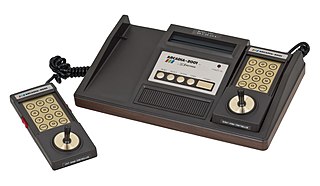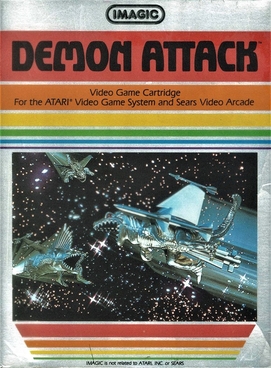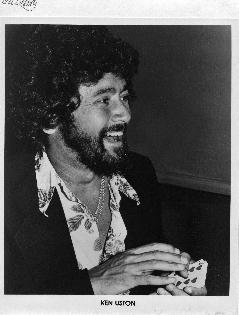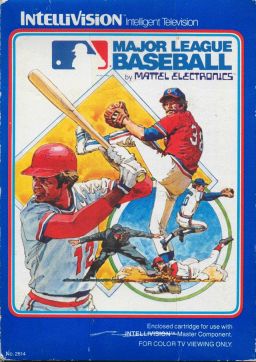Related Research Articles

The Atari 2600 is a home video game console developed and produced by Atari, Inc. Released in September 1977, it popularized microprocessor-based hardware and games stored on swappable ROM cartridges, a format first used with the Fairchild Channel F in 1976. Branded as the Atari Video Computer System from its release until November 1982, the VCS was bundled with two joystick controllers, a conjoined pair of paddle controllers, and a game cartridge—initially Combat and later Pac-Man.

The Arcadia 2001 is a second-generation 8-bit home video game console released by Emerson Radio in May 1982 for a price of US$ 99, several months before the release of ColecoVision. It was discontinued only 18 months later, with a total of 35 games having been released. Emerson licensed the Arcadia 2001 to Bandai, which released it in Japan. Over 30 Arcadia 2001 clones exist.

Coleco Industries, Inc. was an American company founded in 1932 by Maurice Greenberg as The Connecticut Leather Company. It was a successful toy company in the 1980s, mass-producing versions of Cabbage Patch Kids dolls and its video game consoles, the Coleco Telstar dedicated consoles and ColecoVision. While the company ceased operations in 1988 as a result of bankruptcy, the Coleco brand was revived in 2005, and remains active to this day.

The Fairchild Channel F, short for "Channel Fun", is a video game console, the first to be based on a microprocessor and to use ROM cartridges instead of having games built-in. It was released by Fairchild Camera and Instrument in November 1976 across North America at a retail price of US$169.95. It was launched as the "Video Entertainment System", but when Atari released its Video Computer System the next year, Fairchild rebranded their machine as "Channel F" while keeping the Video Entertainment System descriptor.

The Intellivision is a home video game console test marketed by Mattel Electronics in 1979, and officially released in 1980. The name is a portmanteau of "intelligent television". Development began in 1977, the same year as the launch of its main competitor, the Atari 2600. In 1984, Mattel sold its video game assets to a former Mattel Electronics executive and investors, eventually becoming INTV Corporation. Game development ran from 1978 to 1990 when the Intellivision was discontinued. From 1980 to 1983, more than 3 million consoles were sold.

The Magnavox Odyssey 2, also known as Philips Odyssey 2, is a second generation home video game console that was released in 1978. It was sold in Europe as the Philips Videopac G7000, in Brazil and Peru as the Philips Odyssey and in Japan as Odyssey2. The Odyssey 2 was one of the four major home consoles prior to the 1983 video game market crash, along with Atari 2600, Intellivision and ColecoVision.

Pong is a table tennis–themed twitch arcade sports video game, featuring simple two-dimensional graphics, manufactured by Atari and originally released in 1972. It was one of the earliest arcade video games; it was created by Allan Alcorn as a training exercise assigned to him by Atari co-founder Nolan Bushnell, but Bushnell and Atari co-founder Ted Dabney were surprised by the quality of Alcorn's work and decided to manufacture the game. Bushnell based the game's concept on an electronic ping-pong game included in the Magnavox Odyssey, the first home video game console. In response, Magnavox later sued Atari for patent infringement.
The video game crash of 1983 was a large-scale recession in the video game industry that occurred from 1983 to 1985, primarily in the United States. The crash was attributed to several factors, including market saturation in the number of video game consoles and available games, many of which were of poor quality, as well as waning interest in console games in favor of personal computers. Home video game revenues peaked at around $3.2 billion in 1983, then fell to around $100 million by 1985. The crash abruptly ended what is retrospectively considered the second generation of console video gaming in North America. To a lesser extent, the arcade video game market also weakened as the golden age of arcade video games came to an end.

Frogger is a 1981 arcade action game developed by Konami and manufactured by Sega. In North America, it was released by Sega/Gremlin. The object of the game is to direct a series of frogs to their homes by crossing a busy road and a hazardous river.

Pitfall! is a platform video game designed by David Crane for the Atari 2600 and released by Activision in 1982. The player controls Pitfall Harry and is tasked with collecting all the treasures in a jungle within 20 minutes. The world consists of 255 screens which are horizontally connected in a flip screen manner. Each screen has one or more hazards: quicksand, tarpits, rolling logs, crocodiles, snakes, scorpions, campfires, and swinging vines.

Demon Attack is a fixed shooter programmed by Rob Fulop for the Atari 2600 and published by Imagic in 1982. It sold over 2 million cartridges. Demon Attack was ported to the Intellivision, Magnavox Odyssey 2, Atari 8-bit family, VIC-20, Commodore 64, Tandy 1000, TRS-80, IBM PCjr, and TRS-80 Color Computer. There is also a port for the TI-99/4A titled Super Demon Attack.
Fueled by the previous year's release of the colorful and appealing Pac-Man, the audience for arcade video games in 1981 became much wider. Pac-Man influenced maze games began appearing in arcades and on home systems. Pac-Man was the highest-grossing video game for the second year in a row. Nintendo's Donkey Kong defined the unnamed platform game genre, while Konami's Scramble established forced-scrolling shooters. The lesser known Jump Bug combined the two concepts into both the first scrolling platform game and the first platform shooter. Other arcade hits released in 1981 include Defender, Frogger, and the Galaxian sequel Galaga.
1980 saw the release of a number of games with influential concepts, including Pac-Man, Battlezone, Crazy Climber, Mystery House, Missile Command, Phoenix, Rally-X, Space Panic, Stratovox, Zork, Adventure, and Olympic Decathlon. The year's highest-grossing video game was Namco's arcade game Pac-Man, while the best-selling home system was Nintendo's Game & Watch. The Atari VCS also grew in popularity with a port of Space Invaders and support from new third-party developer Activision.

Ken Uston was an American blackjack player, strategist and author, credited with popularizing the concept of team play at blackjack. During the early to mid-1970s he gained widespread notoriety for perfecting techniques to do team card counting in numerous casinos worldwide, earning millions of dollars from the casinos, with some bets as high as $12,000 on a single hand.
In the history of video games, the second generation era refers to computer and video games, video game consoles, and handheld video game consoles available from 1976 to 1982 Notable platforms of the second generation include the Fairchild Channel F, Atari 2600, Intellivision, Odyssey 2, and ColecoVision. The generation began in November 1976 with the release of the Fairchild Channel F. This was followed by the Atari 2600 in 1977, Magnavox Odyssey² in 1978, Intellivision in 1980 and then the Emerson Arcadia 2001, ColecoVision, Atari 5200, and Vectrex, all in 1982. By the end of the era, there were over 15 different consoles. It coincided with, and was partly fuelled by, the golden age of arcade video games. This peak era of popularity and innovation for the medium resulted in many games for second generation home consoles being ports of arcade games. Space Invaders, the first "killer app" arcade game to be ported, was released in 1980 for the Atari 2600, though earlier Atari-published arcade games were ported to the 2600 previously. Coleco packaged Nintendo's Donkey Kong with the ColecoVision when it was released in August 1982.

Baseball is a sport video game produced by Mattel and released for the Intellivision home video game console in 1980. As the best-selling game in the console's history, with more than 1 million copies sold, Baseball put players in control of a nine-man baseball team competing in a standard nine-inning game. When first released, Mattel obtained a license from Major League Baseball, although the only trademarked item used is the MLB logo on the box art. No official team names or player names are in the game.

M Network was a video game division of Mattel that, in the 1980s, produced games in cartridge format for the Atari 2600 video game system.
A vertically scrolling video game or vertical scroller is a video game in which the player views the field of play principally from a top-down perspective, while the background scrolls from the top of the screen to the bottom to create the illusion that the player character is moving in the game world.

The 1970s was the first decade in the history of the video game industry. The 1970s saw the development of some of the earliest video games, chiefly in the arcade game industry, but also several for the earliest video game consoles and personal computers.
References
- ↑ "cyberroach.com review accessed 20 Aug 2006". Archived from the original on 26 October 2006. Retrieved 20 August 2006.
- ↑ Video Games magazine, 1983 January, page 82 Review rating Usefulness 8, "Uston cheats when he uses the word beat. This simply is not a great strategy book."
- ↑ https://openlibrary.org/works/OL4117034W/Ken_Uston's_Guide_to_Buying_and_Beating_the_Home_Video_Games Open Library's "About the Book" and Table of Contents, information.
- ↑ "GAMES Magazine #31". September 1982.